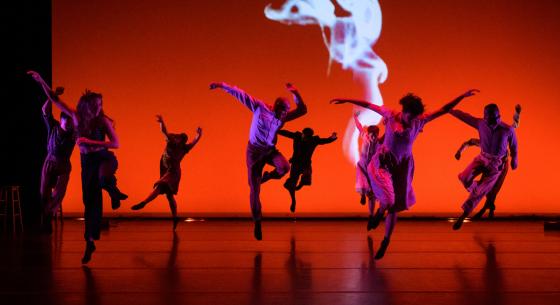Understanding Roussève’s Reality
Halfway to Dawn explores sense of self versus need to belong to a community
As the lights lowered in the theater, someone rushed to take the seat next to me on the aisle. With a casual glance toward him, I immediately recognized that it was David Roussève, the choreographer/director of Halfway to Dawn, the piece we were about to see at the Brooklyn Academy of Music in New York on Dec 6. At the realization that I would be watching the performance next to Roussève, I subtly slid my notepad and pen back into my bag …
The only note I managed to scribble at intermission was this: “Choreography is aggressively modern/postmodern at times while harkening back to jazz/shim-sham at other times.” To say that Halfway to Dawn was straight jazz would be incorrect, although that may be implied by the soundtrack of the performance set to works of jazz musician Billy Strayhorn.
Yes, certainly elements of jazz were represented, specifically in the moments of freeform jam sessions and improvised steps—but that doesn’t entirely capture the spirit of this piece. Yet to call it modern or postmodern doesn’t quite cover it either. When I think of postmodern dance, I think of movement for movement’s sake. But the storytelling element of this performance was also very important, following the events of Strayhorn’s life through video-projected dates and facts. Roussève’s Halfway to Dawn succeeds in blending genres to essentially create a genre all its own. It’s a unique performance that draws on a wide dance vocabulary and several content themes.
In talking with Roussève the day after the performance, our conversation focused on the themes of the piece and how they informed the dancers’ movements. The piece explores Strayhon’s struggles with his own identity, in being an openly gay African American man, making music (often without credit) during the jazz era in America.
I realized the choreography juxtaposes the idea of unison (family, community) against the individual (independence). “We try to find unison in dancing without destroying the sense of individuality,” Roussève adeptly explained. This felt like the most relevant point to take away from Halfway to Dawn as we all strive to balance our competing senses of self and community.
Watching the performance with and then talking to the exceedingly kind Roussève himself certainly enhanced my enjoyment of the work. However, I believe anyone attending this dynamic performance will leave feeling just as inspired. Minnesota audiences can discover this for themselves when Northrop presents Halfway to Dawn on Sat, Apr 13.
